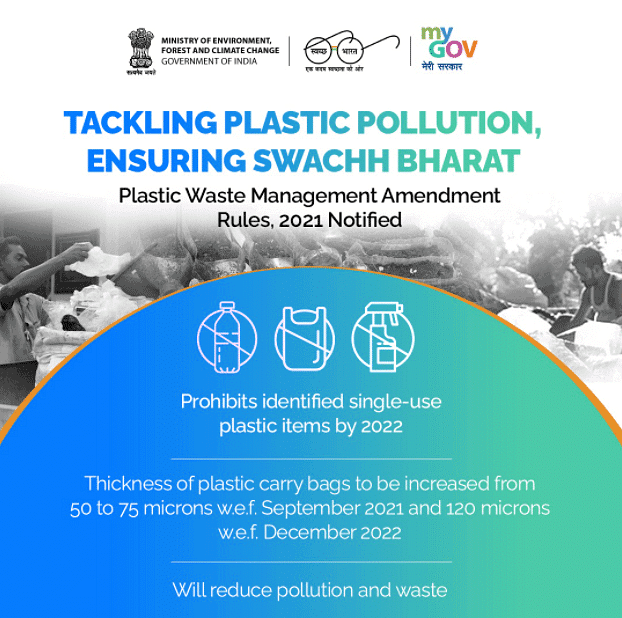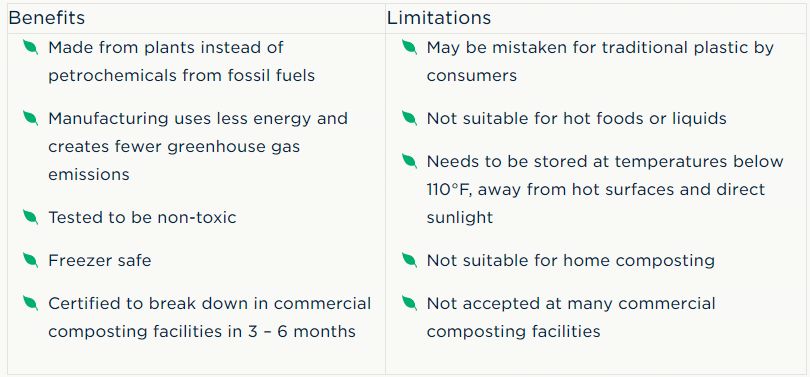Plastic Waste Management | Gist of Rajya Sabha TV / RSTV (now Sansad TV) - UPSC PDF Download
Introduction:
According to a report on Plastic Waste Management released by Ministry of Housing and Urban Affairs, the global average of plastic per capita consumption is 28 kg and India has a per capita plastic consumption of 11 kg. The CPCB Report of 2019-20 states that 3.4 million metric tonnes of plastic waste is generated in India annually. NITI Aayog and UNDP India have recently launched a handbook to promote sustainable management of plastic waste in the country. It has suggested that urban local bodies across states adopt the material recovery facility (MRF) model & implement it as a public-private partnership model for sustainable management of urban plastic waste. Urban local bodies are mandated under the Municipal Solid Waste Management Rules, 2016, and the Plastic Waste Management Rules, 2016, to manage municipal solid waste and plastic waste at the city level. The Environment ministry has also come out with a draft notification for regulation of extended producer responsibility under plastic waste management rules 2016. The draft notification published earlier this month specifies the quantity of waste that will have to be managed by producers, importers and brand owners who generate plastic packaging waste in India.
NITI Aayog and UNDP India’s Sustainable Urban Plastic Waste Management:
- Urban local bodies (ULBs) are mandated under the Municipal Solid Waste Management Rules, 2016, and the Plastic Waste Management Rules, 2016, to manage municipal solid waste and plastic waste at the city level.
- The handbook is a repository of 18 case studies/best practices from India, including 4 from south Asian countries divided into four major components, including
Component I: Technical model for plastic waste recycling and management
This component based on an integrated and inclusive approach by involving different stakeholders and their social benefits, covers, a) Development of a baseline system of plastic waste management at the city level , b) Systems approach for promoting recycling of plastic waste at the city level, c) Stakeholder identification and partnerships, d) Development of regulatory need-gap analysis and proposals for the holistic management of plastic waste.
Component II: Material Recovery Facility – For improved plastic waste management implementation
This component explains the complete functioning of a material recovery facility (MRF), beginning from site identification, construction and waste processing mechanisms at the MRF.
Component III: Institutionalization of MRFs in governance bodies
The mainstreaming of waste pickers in the plastic waste management system would result in improved socio-economic conditions for waste pickers and increased recognition in society. This requires the institutionalization of various recommended models and waste pickers by ULBs for long-term sustainability.
Component IV: IEC and Digitalization
This component includes the development of knowledge management mechanisms by establishing an in-built adoptive feedback system from different stages of plastic waste value chain. It also involves the identification of various technology platforms, or technical service providers, linkages with relevant stakeholders such as bulk waste generators (BWGs), recyclers and waste pickers, and the development of protocols for more effective online reporting, monitoring and information exchange.
- Plastic pollution has become an epidemic. Every year, we throw away enough plastic to circle the Earth four times. Plastics are detrimental to human health because of the chemicals used in their production. These chemicals are used to change the properties of plastics. Humans are exposed to such toxins through air and water, through food such as fish, or direct contact with plastic products. Much of that waste doesn’t make it into a landfill, but instead ends up in our oceans, where it’s responsible for killing one million seabirds and 100,000 marine mammals every year. For the good of the planet, it’s time to rethink how we use plastic.
- Every piece of plastic ever disposed of (this includes the toothbrush your great-grandfather used) is damaging the earth. It’s lying somewhere in the earth, floating in the ocean, or been broken down into microparticles and in the food chain. Although a fraction of the plastic disposed of is recycled, most of it eventually ends up in the ocean or in dump sites outside city limits.

What are single use plastics?
- There is no central and comprehensive definition for single-use plastic, crucial for any ban to be successful.
- Governments currently use various definitions.
- The problems caused by them were recognized in 2007.
- It has been found everywhere ie right from depth of the oceans to the peaks of Himalayas.
- Single used plastics are used once and thrown away.
- They accumulate in the water bodies and choke the drains which lead to floods.
Plastic Waste Management Rules, 2016:
Increase minimum thickness of plastic carry bags from 40 to 50 microns and stipulate minimum thickness of 50 micron for plastic sheets also to facilitate collection and recycle of plastic waste,
Expand the jurisdiction of applicability from the municipal area to rural areas, because plastic has reached rural areas also:
- To bring in the responsibilities of producers and generators, to introduce collect back system of plastic waste by the producers/brand owners;
- To introduce collection of plastic waste management fee;
- To promote use of plastic waste for road construction for gainful utilization of waste and also address the waste disposal issue
Common sources of Plastic pollution:
- Merchant ships expel cargo, sewage, used medical equipment, and other types of waste that contain plastic into the ocean.
- The largest ocean-based source of plastic pollution is discarded fishing gear (including traps and nets).
- Continental plastic litter such as Food Wrappers & Containers, Bottles and container caps, Plastic bags, Straws and stirrers etc. enters the ocean largely through storm-water runoff.
India’s efforts to beat plastic pollution:
- So far, 22 States and Union Territories have joined the fight to beat the plastic pollution, announcing a ban on single-use plastics such as carry bags, cups, plates, cutlery, straws and thermocol products.
- India has also won global acclaim for its “Beat Plastic Pollution” resolve declared on World Environment Day last year, under which it pledged to eliminate single-use plastic by 2022.
- All such efforts have yielded positive results: Voluntary initiatives are having an impact in many States, as citizens reduce, reuse and sort their waste. A Bengaluru waste collective estimates that the volume of plastic waste that they collect dropped from about two tonnes a day to less than 100 kg.
Efforts at International level to curb Plastic waste:
- Local policies and actions such as bans on micro beads and single-use plastic bags are spreading across the globe, but there are only a handful of international documents focused on plastic pollution.
- International Convention for the Prevention of Pollution from Ships, later modified as MARPOL, is an international agreement that addresses plastic pollution. MARPOL, the Honolulu Strategy, was a great first step.
- But even after MARPOL came into force, dumping of plastic waste into sea has not reduced. Steps to prevent plastic waste lack defined reduction targets, methods to monitor progress.
In 2011, the National Oceanic and Atmospheric Administration (NOAA) in the United States and UNEP created the Honolulu Strategy—a planning tool to reduce plastic pollution and its impacts.
In 2012, a voluntary commitment of a significant reduction of marine debris was introduced at Rio+20 with a deadline of 2025.
In February 2017, UNEP announced the Clean Seas campaign, asking for individuals, industries, and member states to voluntarily commit to an action of their choice to reduce plastic pollution.
United Nations Environment Assembly in Nairobi, more than 193 nations passed a resolution to eliminate plastic pollution in our seas. However, it’s not a legally binding treaty.
Solutions:
- Various alternatives should be looked for. Great civilizations have flourished without use of plastic but today with modern technology we are not able to find out a solution.
- Proper ground level awareness should be done.
- Local actions are required for mitigating plastic pollution, using mechanisms such as bans on plastic bags, maximum daily limits for emissions into watersheds, and incentives for fishing gear retrieval.
- Behavioural changes are required and government needs to work on it.
- Countries should come together to establish measurable reduction targets for plastic waste. A meaningful international agreement—one with clearly defined waste reduction targets is the need of the hour.
- Effective policies must take into account all stages of the lifecycle of plastic—connecting producers to users and ultimately to waste managers.
- Fossil fuel subsidies incentivise the plastic market. Hence, Countries should end fossil fuel subsidies. Annually, 4–8% of oil is used to produce raw plastic.
- India has a major problem dealing with plastics, particularly single-use shopping bags that reach dumping sites, rivers and wetlands along with other waste.
- The most efficient way to deal with the pollution is to control the production and distribution of plastics.
- Banning single-use bags and making consumers pay a significant amount for the more durable ones is a feasible solution.
- Enforcing the Solid Waste Management Rules, 2016, which require segregation of waste will retrieve materials and greatly reduce the burden on the environment.
- Waste separation can be achieved in partnership with the community, and presents a major employment opportunity
Way Forward:
- Cost benefit analysis has to be done for each type of plastic and we need to start replacing them at industry level.
- Need to destroy plastic by use of technology which cause no pollution.
- Success will require collaboration and coordinated efforts across many sectors – some that create near-term progress and others that require major investments with longer timelines.
- Addressing plastic waste in the environment and developing a circular economy of plastics requires the participation of everyone across the entire value chain and the long term commitment of businesses, governments, and communities.
|
156 videos|763 docs
|






















